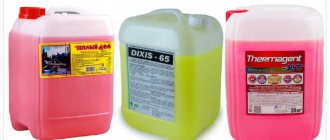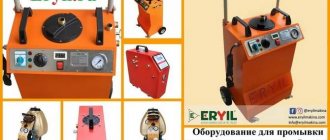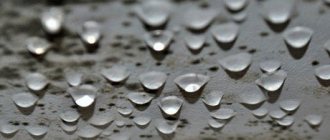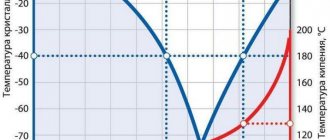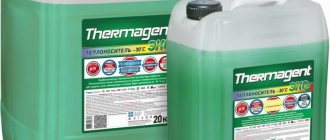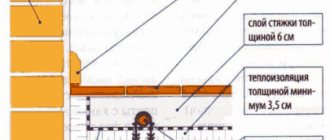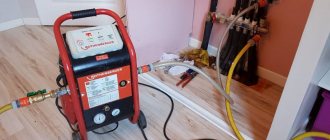Coolant "Warm House" is an inexpensive, non-hazardous and high-quality composition intended for heating systems. In addition, it is not only able to protect the equipment used, but also a safe, environmentally friendly product. It contains protective components that increase its ability to resist scale formation, there is almost no foam formation and the composition is able to slow down corrosion.
Pros and cons of the product
It has the following properties:
- The operating temperature difference ranges from -30 to +106 degrees;
- The working life of the fluid is about 5 years;
- Safe for flax , paronite, rubber, plastic and metal-plastic, eliminating possible leaks;
- Safe substance for humans and animals;
- If the coolant is used only for heating , then its service life increases to 10 years;
- Explosion- and fireproof liquid.
Among the shortcomings it is worth mentioning the following:
- Inability to use electrolysis colas when heating a room;
- The presence of salt in the composition increases corrosion;
- It is necessary to use a composition designed for one of the operating temperatures. The use of a coolant with unsuitable temperature characteristics increases the possibility of glycol deposits forming, which threatens the failure of heating elements and the appearance of resinous deposits;
- Dilution of the “Warm House” composition with other liquids without testing may cause decomposition of additives and reduce the ability of the composition to resist corrosion.
Main characteristics of antifreeze
A number of non-freezing liquids “Warm House” contain products based on ethylene glycol and propylene glycol.
Both types of coolants are created according to environmental safety rules. Antifreeze does not freeze even at critical temperatures, so you can safely leave the house unattended for the weekend. The solution does not harm rubber, metal-plastic, plastic and flax. Read also: types of antifreeze for heating systems of private houses.
Model line
For the convenience of consumers, the manufacturer has presented several types of antifreeze.
In this video we will look at the types of antifreeze “Warm House”: The model line includes the following products:
- ECO-20. Green non-freezing liquid. The solution is based on propylene glycol. Can be used for two types of heating equipment, but is primarily produced for double-circuit boilers.
- Series 30. Red composition based on ethylene glycol. Ideal for single-circuit systems, but can also be used for dual-circuit equipment. The solution should be diluted with water according to the instructions. This antifreeze cannot be used in its pure form.
- ECO-30. Green solution with propylene glycol. Before use, the composition should be diluted with water to -20°C.
- Episode 60. Red liquid with a high content of ethylene glycol. The manufacturer recommends mixing antifreeze with water down to -20...-30°C.
Advantages and disadvantages
All types of Warm House antifreeze have their pros and cons.
The following advantages of this product can be highlighted:
- Wide range of temperature modes from -30 to +106°C.
- Long service life (from 5 to 8 years).
- Safety for heating system, prevent leakage with good sealing.
- Environmentally friendly, no toxic fumes during weathering.
- Absolute fire safety.
Any tool has its drawbacks. Antifreeze "Warm House" is no exception. Users highlight the following disadvantages:
- Antifreeze liquids are only suitable for gas heating. The solutions cannot be used in heating equipment with an electric boiler.
- Some types of antifreeze contain a high concentration of salt. This may contribute to the formation of scale.
- To achieve the desired effect, you need to mix the solution and water exactly according to the instructions. Failure to follow recommendations may result in carbon deposits.
The liquid must not be mixed with other antifreezes. When diluted, the additive package loses its properties. Moreover, dilution neutralizes the anti-corrosion effect.
Characteristics and types of coolant
The following brands of coolant are produced:
- “Warm House ECO-20” is an antifreeze made from propylene glycol. Ideal for dual-circuit heating devices;
- “Warm House -30” is an antifreeze made from ethylene glycol, used for heating with single-circuit boilers, but it is also suitable for other designs. When filling systems of double-circuit and tensile boilers, dilution is required;
- “Warm House ECO-30” is made from propylene glycol. When filling systems of double-circuit and tensile boilers, dilution is required;
- “Warm House -65” is a high-concentration composition made from ethylene glycol.
Completely prepared formulations are already diluted to the required concentration.
“Warm House -65” - high concentration composition, produced from ethylene glycol
Application of compositions
The coolant of this brand is a liquid and is more fluid than water. For this reason, it is necessary to install the heating efficiently, after which the system must be pressure tested. Do not forget that it is prohibited to pour this liquid into electrolysis boilers.
Before use, most “Warm House” compositions are diluted with technical or distilled water. After dilution by 10%, its crystallization temperature increases to -25 degrees; if you dilute it to 20%, the characteristics of the solution will change to -20 degrees. After some time of operation, the coolant will begin to become jelly-like. If you dilute it with water at this time, the solution will restore its characteristics.
It is necessary to install the heating efficiently, after which the system must be pressure tested
Recipe for mixing 100 liters of coolant
“Warm Home” is often sold as a concentrate, which must be diluted before use. The proportions of the components affect the characteristics of the final solution (freezing point). If you add 23 liters of water to 77 liters of concentrate, the freezing point of the resulting solution will be about -40 degrees.
By dissolving 35 liters of water in 65 liters of concentrate, you will get a solution that can freeze only at -30 degrees. Adding 40 liters of water to 60 liters of concentrate will give you a mixture that will freeze at 25 degrees below zero. If the frost in your region is no more than 20 degrees, then you need to dilute 54 liters of concentrate with 46 liters of water.
In the equipment, all joints are treated with sealing compounds that are well resistant to the effects of glycol mixtures, or flax is used for this purpose. After the end of its service life, the solution still freezes only at low temperatures, but its anti-corrosion properties are significantly deteriorated.
For this reason, after the end of its useful life, the coolant must be drained and disposed of. Before filling the system with a new solution, be sure to check all components for leaks and completely flush the heating system.
After the end of its service life, the solution still freezes only at low temperatures, but its anti-corrosion properties are significantly deteriorated
What are the disadvantages of water as a coolant for heated floors?
The main disadvantage of water as a coolant is that it freezes at subzero temperatures.
But this minus does not apply to permanent residences.
Agree, if force majeure circumstances occur , for example, the electricity is turned off or the boiler breaks down, you will not sit back and wait for the house and all utilities to freeze .
A water heated floor is a heat-inertial system that works like a heat accumulator and retains heat for a long time.
Reviews
Plumber1979, Moscow We use “Warm House” -65 in our heating. It is often counterfeited, but if you buy it from a trusted store, you can hope that it will serve well. Convinced by my own experience.
Sarychev, Obninsk I pour this coolant into the heating myself. But my heating system is low temperature. The temperature is no more than 60 degrees (if it’s 20 outside). It works fine, for heating with temperatures up to 80 degrees, the additives will probably decompose. You must carefully read the certificates to determine the highest operating temperature it can be used. Please also note that heating elements are designed to work with water.
Egor, Kizil I purchased the “Warm House” composition - as soon as I filled the system with the pump, I immediately noticed that the gaskets were leaking. If you use water instead of coolant, then after it you need to tighten all the connections; it is a very fluid liquid. There are no complaints during operation; in winter, this mixture heated the house normally. When we left it for almost three weeks, it did not freeze.
Artem, Syktyvkar Installed an imported heating system and foreign pipes and fittings. But there was no longer enough money to buy 200 liters of imported coolant, so I used “Warm House”. The boiler works great with it, there are no system leaks.
Evgeniy, Pevek If you remember that new antifreeze needs to be added every 5-6 years, my decision to use this mixture will not surprise anyone - it is not very expensive and does not spoil the heating system. True, there is a slight doubt whether its freezing temperature will be enough for the northern regions.
What other disadvantages do antifreezes have?
Antifreezes are sold in the form of concentrates, which the consumer independently dilutes with water, or in the form of solutions ready for use in the heating system.
Important! Antifreeze causes corrosion of metal parts of the heating system . It is also better to use gaskets made of glycol-resistant materials in the system - paronite or Teflon. To prevent accelerated corrosion, inhibitors are added to antifreeze - silicate or carboxylate additives. Antifreeze may include:
- anti-foaming agents;
- surface restoration additives;
- absorbents.
Antifreezes, due to their lower surface tension coefficient than water, have greater fluidity. This can lead to heating system leaks at the connections.
Note!
The density and dynamic viscosity of propylene glycol is greater than that of water and you will need a more powerful circulation pump.
Blitz tips
If you dilute the coolant with water from a well or well, which contains a lot of minerals, then it is advisable to dilute the mixture in a transparent container in order to notice the formation of sediment in time. Considering that in some regions the water is of very low quality, it is advisable in this case to use completely ready-made formulations.
Not recommended:
- Fill galvanized systems because sediment may form from the coolant as a result of a chemical reaction;
- Use the composition in heating with electrolysis boilers;
- Mixing “Warm House” with similar products may cause a decrease in performance properties and service life;
- Overheat the coolant.
The compositions “Warm House -30” and “Warm House -65” are produced only for technical purposes (it contains poisonous ethylene glycol). To prevent poisoning, this composition should not be allowed to get into drinking water or food. If it gets on the skin, the area must be washed well with soapy water.
"Warm House-ECO" is suitable as a refrigerant in food production. But this does not mean at all that, for example, you can drink it. All types of coolant are explosion-proof and do not support combustion.
If necessary, the coolant must be stored in an airtight container, inaccessible and protected from sunlight; they should not be placed near food products.
How are they different from each other? I heard that ethylene glycol is poisonous, is this true?
Ethylene glycol is a hydrocarbon-based chemical compound – a dihydric alcohol. Ethylene glycol is a clear, slightly oily, colorless, odorless liquid.
Ethylene glycol, according to the degree of impact on the human body, belongs to substances of the 3rd hazard class. If ethylene glycol enters the body, it can be fatal. Ethylene glycol vapors are also dangerous, especially if inhaled for a long time.
Propylene glycol , like ethylene glycol, is a colorless and viscous liquid. But, unlike ethylene glycol, propylene glycol is not a toxic substance! It is used in perfumery and in the food industry as an additive E-1520. The use of propylene glycol is permitted in most EU countries.
